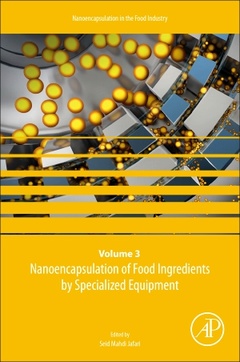Description
Nanoencapsulation of Food Ingredients by Specialized Equipment
Volume 3 in the Nanoencapsulation in the Food Industry series
Nanoencapsulation in the Food Industry Series
Language: English
Keywords
Bioactive compounds; Bioactives; Bioavailability; Controlled release; Electrospinning; Electrospraying; Emulsions; Encapsulation; Equipment; Food bioactive; Food bioactive compounds; Food bioactive ingredients; Food bioactives; Food hydrocolloids; Functional foods; Glass microfluidic devices; High-pressure homogenization; Microfluidization; Nano spray drying; Nanocarriers; Nanoemulsions; Nanoencapsulation; Nanofibers; Nanoliposomes; Nanoparticles; Nanostructures; Packaging; Polysaccharides; Powder; Proteins; Release; Solid lipid nanoparticles; Sonication; Top-down approaches
478 p. · 15x22.8 cm · Paperback
Description
/li>Contents
/li>Readership
/li>Comment
/li>
Nanoencapsulation of Food Ingredients by Specialized Equipment, Third Edition, a new volume in the Nanoencapsulation in the Food Industry series provides an overview of specialized developed equipment for the nanoencapsulation of food ingredients. Electro-spinning, electro-spraying, nano-spray dryer, micro/nano-fluidics systems and sonication devices are just some of the equipment analyzed in the book. Each chapter reviews the mechanisms of innovative devices for preparation of nanostructures, exploring the key factors in each device to control the efficiency of nanoencapsulation and revealing the morphologies and properties of nanoencapsulated ingredients produced by each equipment.
Authored by a team of global experts in the fields of nano and microencapsulation of food, nutraceutical, and pharmaceutical ingredients, this title is of great value to those engaged in the various fields of of nanoencapsulation.
1. Production of bioactive-loaded nanofibers by electrospinning
2. Production of bioactive-loaded nanoparticles by electrospraying
3. Production of bioactive-loaded nanoparticles by nano spray dryer
4. Production of bioactive-loaded nanocapsules by micro/nanofluidics
5. Production of bioactive-loaded nanocapsules by high pressure homogenizers
6. Production of bioactive-loaded nanocapsules by ultrasound devices
academics, students, researchers, practitioners, and those who are working or interested in various fields of micro/nanoencapsulation of food, nutraceutical, and pharmaceutical ingredients particularly in the food and pharmaceutical areas.
- Thoroughly explores the mechanisms of nanoencapsulation by specialized equipment
- Elucidates the key factors in each device to control the efficiency of nanoencapsulation
- Discusses the morphologies and properties of nanoencapsulated ingredients produced by each equipment




